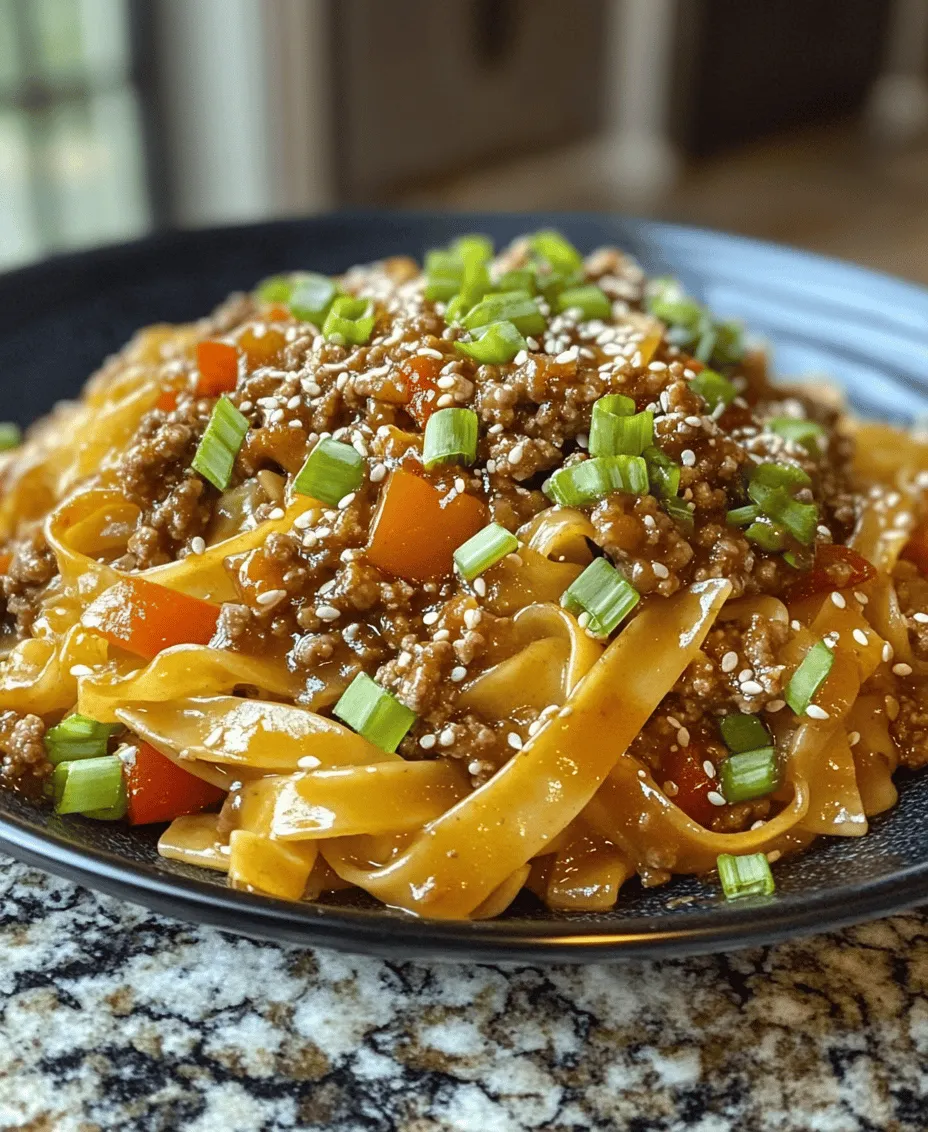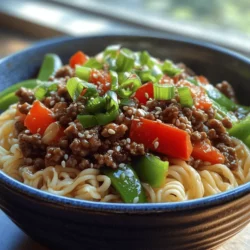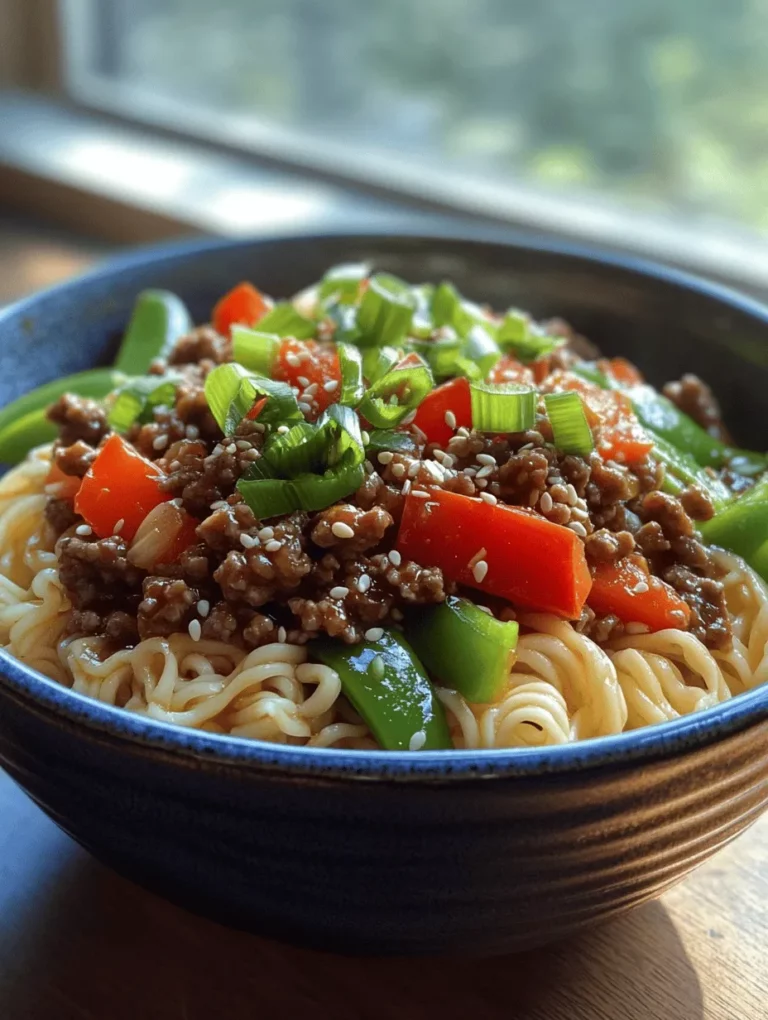Introduction
Mongolian Ground Beef Noodles is a dish that beautifully balances rich, savory flavors with the hearty satisfaction of a wholesome meal. Originating from the culinary traditions of Mongolian cuisine, this dish has evolved to incorporate influences from various Asian cooking methods, making it a favorite among many food enthusiasts. The combination of tender ground beef, vibrant vegetables, and silky egg noodles creates a delightful harmony on the palate, ensuring that each bite is packed with flavor.
One of the most appealing aspects of Mongolian Ground Beef Noodles is its versatility. Whether you’re looking for a quick weeknight dinner or a dish that can impress guests at a special occasion, this recipe fits the bill. It can be prepared in under 30 minutes, making it a convenient choice for busy families or anyone looking to whip up a satisfying meal without spending hours in the kitchen. Moreover, the dish is easily customizable, allowing you to incorporate your favorite vegetables or adjust the spice levels to cater to your family’s tastes.
In addition to its enticing flavors, this dish offers a well-rounded nutritional profile. The ground beef provides a good source of protein, while the fresh vegetables add essential vitamins and minerals. With the addition of egg noodles, you have a complete meal that is both filling and nutritious. Whether enjoyed as a solo dish or served alongside a fresh salad, Mongolian Ground Beef Noodles is sure to please everyone at the table.
Understanding the Key Ingredients
To master the art of preparing Mongolian Ground Beef Noodles, it’s essential to understand the key ingredients that contribute to its unique flavor and texture. Each component plays a vital role, and selecting high-quality ingredients can elevate the dish to new heights.
Ground Beef
At the heart of this recipe is the ground beef, which serves as the primary protein source. When selecting ground beef, quality is paramount. Look for beef that is 80% lean and 20% fat, as this ratio strikes a perfect balance between flavor and moisture. The fat content is crucial; too lean, and the beef can dry out during cooking, while too fatty can result in an overly greasy dish.
Sourcing your ground beef from a reputable butcher or grocery store can also make a difference. Grass-fed beef is often a healthier choice, offering a richer flavor and higher levels of omega-3 fatty acids. If you have dietary preferences, you can substitute ground beef with ground turkey, chicken, or even plant-based alternatives for a lighter or vegetarian version.
Egg Noodles
Egg noodles are another essential component of Mongolian Ground Beef Noodles, known for their smooth texture and ability to hold sauces well. These noodles are made from wheat flour and eggs, which give them a rich flavor and a slightly chewy bite. In Asian cuisine, egg noodles are celebrated for their versatility and can be found in various forms, from flat to round.
When cooking egg noodles, it’s important to follow the package instructions to achieve the perfect texture. Typically, they require only a few minutes of boiling before they are ready. For those with dietary restrictions, alternatives such as rice noodles or even zucchini noodles can be used, although this may slightly alter the dish’s traditional flavor profile.
Fresh Vegetables
Fresh vegetables are key to adding color, texture, and nutrition to the dish. The classic combination of bell pepper, onion, garlic, ginger, and snow peas not only enhances the overall flavor but also makes the dish visually appealing.
– Bell Pepper: Offers a sweet crunch and a bright pop of color. Rich in vitamins A and C, bell peppers are a nutritious addition that also adds natural sweetness.
– Onion: Provides a savory base flavor. When sautéed, onions become soft and caramelized, adding depth to the dish.
– Garlic and Ginger: These aromatics are essential in Asian cooking, contributing a fragrant and zesty kick. They also have health benefits, including anti-inflammatory properties.
– Snow Peas: These tender, crisp peas add a delightful snap to each bite and are a great source of dietary fiber and vitamins.
Incorporating a variety of vegetables not only enhances the nutritional value of the dish but also makes it more visually appealing. Feel free to add other favorites, like carrots or broccoli, to suit your palate.
Flavorful Sauce Components
The true magic of Mongolian Ground Beef Noodles lies in its flavorful sauce, which ties all the ingredients together. The sauce is a harmonious blend of soy sauce, hoisin sauce, rice vinegar, and sesame oil, each contributing distinct flavor profiles.
– Soy Sauce: This staple in Asian cuisine provides a salty, umami flavor that enhances the dish’s overall taste. Opt for low-sodium soy sauce to control the saltiness without sacrificing flavor.
– Hoisin Sauce: A sweet and tangy sauce, hoisin adds depth and complexity, complementing the savory notes of the beef.
– Rice Vinegar: This mild vinegar adds a touch of acidity, balancing the richness of the beef and sauces. It also brightens the overall flavor profile.
– Sesame Oil: A little goes a long way with sesame oil, which imparts a nutty aroma and flavor that enhances the dish without overwhelming it.
Together, these sauce components create a well-rounded flavor that coats the noodles and complements the beef and vegetables beautifully. Adjust the quantities based on your taste preferences to achieve your desired flavor balance.
Preparation Steps for Mongolian Ground Beef Noodles
Now that you have a solid understanding of the key ingredients, it’s time to dive into the preparation steps for Mongolian Ground Beef Noodles. Each stage is crucial for achieving the perfect balance of flavors and textures.
Cooking the Noodles
The first step in preparing this dish is cooking the egg noodles. Start by bringing a large pot of salted water to a rolling boil. Once boiling, add the noodles and cook according to the package instructions, usually around 3-5 minutes. To ensure the noodles don’t become sticky, stir them gently during the first minute of cooking.
Once the noodles are cooked to al dente (they should still have a slight bite), drain them in a colander and rinse them under cold water. This stops the cooking process and prevents them from clumping together. If desired, toss the noodles with a little bit of sesame oil to prevent stickiness and to add a light flavor.
Browning the Beef
Next, it’s time to cook the ground beef. In a large skillet or wok, heat a tablespoon of cooking oil over medium-high heat. Once hot, add the ground beef, breaking it apart with a wooden spoon. Cook until browned, about 5-7 minutes.
Browning the beef is crucial as it develops rich flavors through the Maillard reaction. Ensure that the beef is cooked evenly, stirring occasionally. Once browned, drain any excess grease from the skillet to keep the dish from becoming overly greasy. If you prefer leaner beef, this step is especially important.
Sautéing Vegetables
With the beef browned, it’s now time to sauté the vegetables. In the same skillet, add a bit more oil if necessary, then toss in the diced onion, minced garlic, and grated ginger. Sauté these aromatics for about 2-3 minutes until the onion becomes translucent and fragrant.
Next, add the sliced bell pepper and snow peas to the skillet. Continue to sauté for another 3-4 minutes, stirring frequently to ensure even cooking. The goal is to achieve a tender-crisp texture for the vegetables, allowing them to retain their vibrant color and nutritional value. Avoid overcooking, as this can lead to mushy vegetables that lose their appeal.
By focusing on these preparation steps, you set the stage for a delicious and satisfying dish. Each element, from the perfectly cooked noodles to the well-browned beef and vibrant vegetables, plays a crucial role in creating the final result of Mongolian Ground Beef Noodles. With the ingredients and techniques outlined here, you’re well on your way to crafting a meal that is sure to impress.

Stir-Frying Techniques
Stir-frying is an essential technique for creating the perfect Mongolian Ground Beef Noodles, as it allows for quick cooking while preserving the vibrant colors and crisp textures of the vegetables. Here are some important tips to master stir-frying:
1. High Heat is Key: Begin by preheating your wok or large skillet over high heat. The goal is to create a sizzling environment that quickly seals in the flavors and moisture of your ingredients.
2. Add Ingredients in Stages: When stir-frying, always add your ingredients in stages based on their cooking times. Start with the ground beef, ensuring it browns evenly before adding the vegetables. This approach ensures that each component is cooked to perfection without becoming mushy.
3. Use the Right Oil: Utilize oils with high smoke points such as canola, vegetable, or peanut oil. These oils can withstand the heat without burning and contribute to a rich flavor.
4. Keep It Moving: Stir constantly to ensure even cooking and prevent sticking. Use a spatula to push ingredients from the sides of the pan towards the center, allowing for quick cooking and uniform heat distribution.
5. Timing for Vegetables: Add vegetables that require longer cooking times, like bell peppers or onions, first. For quicker-cooking vegetables, such as snap peas or broccoli, add them later to maintain their crispness.
Crafting the Sauce
The sauce is what brings this dish to life, offering a harmonious blend of flavors. Here’s how to craft and incorporate the sauce effectively:
1. Mixing the Sauce: In a bowl, combine soy sauce, oyster sauce, hoisin sauce, minced garlic, ginger, and a splash of sesame oil. Adjust the quantities to suit your taste preferences, balancing salty, sweet, and savory notes.
2. Incorporating the Sauce: Once your ground beef and vegetables are nearly cooked, pour the sauce over them. Ensure you stir well to coat all the ingredients evenly. This step is crucial; it allows the flavors to meld and ensures that every bite is full of the rich, umami taste characteristic of Mongolian cuisine.
3. Adjusting Consistency: If you prefer a thicker sauce, you can mix a teaspoon of cornstarch with a tablespoon of water and add it to the pan. This will thicken the sauce while providing an appealing gloss.
Combining Ingredients
Once you have stir-fried the ground beef and vegetables and incorporated the sauce, it’s time to bring everything together:
1. Mixing Noodles: Add your pre-cooked noodles directly into the stir-fry mixture. The noodles should be warm and pliable, allowing them to absorb the sauce while adding a hearty texture to the dish.
2. Tossing for Flavor: Using tongs or a spatula, gently toss the noodles with the beef and vegetable mixture. This step is essential in ensuring that the noodles are evenly coated with sauce and that the flavors are well-distributed throughout the dish.
3. Final Taste Check: Once everything is combined, do a final taste test. This is the moment to adjust any seasonings if desired—more soy sauce for saltiness or a dash of chili sauce for some heat.
Serving Suggestions and Presentation
Presenting your Mongolian Ground Beef Noodles beautifully can enhance the dining experience. Here are some tips to elevate your dish:
1. Plate with Care: Use a large, shallow bowl to serve the noodles. Twirl the noodles into a mound for a visually appealing presentation. You can also layer some beef and vegetables on top for an attractive look.
2. Garnishing: Fresh herbs and garnishes can brighten up the dish. Finely chop green onions and sprinkle them generously over the top. A light sprinkle of sesame seeds can add texture and a nutty flavor.
3. Add Color: Consider incorporating a side of pickled vegetables or a colorful salad to add contrast to your main dish. The combination of colors makes the meal more inviting and appetizing.
4. Serving Suggestion: Pair your noodles with a light Asian-inspired soup or some crispy spring rolls for a complete meal. This not only rounds out the flavors but also provides a delightful variety of textures.
Nutritional Information and Benefits
Mongolian Ground Beef Noodles are not only delicious but also offer a range of nutritional benefits:
– Calories: A typical serving contains around 450-550 calories, depending on the specific ingredients used, such as the type of noodles and the amount of sauce.
– Protein: With ground beef as the primary protein source, each serving provides approximately 25-30 grams of protein, supporting muscle growth and repair.
– Vitamins and Minerals: The inclusion of vegetables like bell peppers and carrots adds essential vitamins A and C, along with dietary fiber, which is important for digestive health.
– Balanced Meal: This dish provides a good balance of carbohydrates from the noodles, protein from the beef, and a variety of vitamins and minerals from the vegetables, making it a well-rounded meal option.
Variations and Substitutions
To cater to different dietary preferences, consider these variations and substitutions:
Protein Alternatives
– Chicken or Turkey: For a leaner option, ground chicken or turkey can be an excellent substitute. They offer similar flavors but with less fat content.
– Plant-Based Options: For a vegetarian or vegan version, use textured vegetable protein (TVP) or a plant-based ground meat alternative. These options provide protein while keeping the dish meat-free.
Vegetable Swaps
Feel free to customize the vegetable mix based on your preferences or what you have on hand. Some great options include:
– Zucchini: Adds a mild flavor and absorbs the sauce beautifully.
– Mushrooms: Introduce an earthy flavor and a meaty texture.
– Broccoli: Provides a crunchy texture and is rich in vitamins.
Gluten-Free Options
For those with gluten sensitivities:
– Gluten-Free Noodles: Look for rice noodles or gluten-free pasta alternatives, which work well with the dish’s flavors.
– Sauce Alternatives: Use tamari instead of soy sauce for a gluten-free option. Always check the labels for other sauces to ensure they meet gluten-free standards.
Cultural Significance of Mongolian Cuisine
Mongolian cuisine is known for its hearty and robust flavors, often reflecting the nomadic lifestyle of the Mongolian people. Traditional dishes emphasize meat, dairy, and grains, with an emphasis on simple cooking methods that highlight the natural flavors of the ingredients.
Stir-frying, as employed in the Mongolian Ground Beef Noodles, showcases a blend of influences from neighboring cultures, particularly Chinese cuisine. The use of soy sauce, garlic, and ginger in this dish exemplifies the fusion of flavors that has evolved over generations. Mongolian cuisine celebrates communal dining, often featuring dishes that are shared among family and friends, making meals a centerpiece of social gatherings.
Conclusion
Mongolian Ground Beef Noodles is a flavorful, satisfying dish that can easily be prepared in your own kitchen. With its combination of tender beef, crisp vegetables, and savory sauce, this recipe is sure to become a favorite in your household. The stir-frying technique ensures that the ingredients maintain their vibrant colors and textures, while the sauce ties everything together in a delightful harmony of flavors.
Whether you’re looking for a quick weeknight dinner or a dish to impress guests, Mongolian Ground Beef Noodles is versatile, customizable, and packed with nutrition. Don’t hesitate to experiment with different proteins, vegetables, and sauces to make it your own.
Enjoy the delicious blend of flavors and textures that make this dish a delightful addition to your cooking repertoire. Get started today, and savor the culinary adventure that is Mongolian cuisine!

